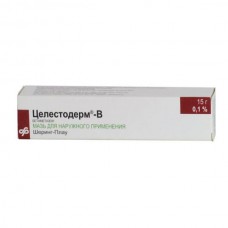Expiration date: 08/2026
The composition and form of issue:
Ointment 1g contains:
betamethasone 1 mg
(in the form of betamethasone 17-valerate)
excipients: white soft paraffin liquid paraffin
in tubes of 15 or 30 grams in a cardboard box 1 tuba.
Cream 1g contains:
betamethasone 1 mg
(in the form of betamethasone 17-valerate)
excipients: white soft paraffin cetostearyl alcohol liquid paraffin macrogol cetostearyl ether phosphoric acid sodium dihydrogen phosphate dihydrate chlorocresol the sodium hydroxide or phosphoric acid (to determine pH) purified water
in tubes of 15 or 30 grams in a cardboard box 1 tuba.
Description pharmaceutical form:
Cream: homogeneous, white, soft consistency, containing no visible particles.
Ointment: homogeneous, white, soft consistency, containing no visible particles.
Description pharmacological action:
Betamethasone has anti-inflammatory and anti-allergic effect through the inhibition of release of cytokines and inflammatory mediators, reduce the metabolism of arachidonic acid, inducing the formation lipokortinov with anti-edematous activity, reducing vascular permeability.
Microdisperse GKS in this non-greasy, odorless, does not leave marks on clothing, is easily washed off the ointment or cream base assures effective penetration of the skin and rapid onset of action.
Indications:
Inflammatory diseases of the skin, amenable to glucocorticoid-therapy (adults and children from 6 months):
- (atopica, children's, coin-like)
- dermatitis (contact, seborainey, Sunny, exfoliativei, radiation, intertriginous)
- atopic dermatitis
- psoriasis
- anogenital and senile pruritus.
Contraindications:
- hypersensitivity to any component of the drug
- pregnancy (high doses, long treatment)
- lactation
- children up to age 6 months.
Application of pregnancy and breast-feeding:
Due to the fact that the safety of locally applied corticosteroids in pregnant women is not established, the appointment of agents of this class in pregnancy is justified only if the benefit to the mother clearly outweighs the potential harm to the fetus. These drugs should not be used in pregnant women in large doses for a long time.
As far not established whether corticosteroids for local application and systemic absorption to penetrate into the breast milk, at the time of treatment should stop breast-feeding or the drug, taking into account how its application is necessary for the mother.
Side effects:
With the use of corticosteroids for local effects was observed following adverse events: burning, irritation and dryness, folliculitis, hypertrichosis, pustular rash, hypopigmentation, perioral dermatitis, allergic contact dermatitis, maceration of skin, secondary infection, skin atrophy, striae and miliaria.
Method of application and dose:
Externally, a thin layer on the affected skin.
Applied 1-3 times daily, depending on the severity of the disease. In most cases, just 1-2 times a day.
Overdose:
Symptoms: excessive or prolonged use of local corticosteroids may cause inhibition of the function of the pituitary-adrenal system, which can be a cause of secondary insufficiency of the adrenal cortex and symptoms of hypercortisolism, including Cushing's syndrome.
Treatment: symptomatic. Acute symptoms of hypercortisolism are usually reversible. If necessary, shows the correction of electrolyte imbalance. In the case of chronic toxic effect the gradual elimination of corticosteroids.
Special instructions:
In the absence of effect from treatment for 2 weeks is recommended to consult a doctor for possible diagnosis.
If you experience irritation or hypersensitivity reactions, treatment should be discontinued and the patient to choose the adequate therapy. Secondary fungal or bacterial skin infection requires appropriate antimicrobial or antifungal therapy (in the absence of a fast positive effect, the use of corticosteroids should be discontinued until, until you have eliminated all signs of infection).
Any side-effects of systemic corticosteroids, including the inhibition of the function of the adrenal cortex, can be observed also with the use of local corticosteroids, especially in children.
Systemic absorption of local corticosteroids improves their long-term use in the treatment of extensive body surfaces or when using occlusive dressings, as well as in children.
Celestoderm-In are shown for external use only and is not intended for use in ophthalmology.
Use in Pediatrics
Celestoderm-In can be used to treat children aged from 6 months.
Children may be more receptive to the application of local corticosteroids causing inhibition of the hypothalamic-pituitary-adrenal (GGN) than older patients, due to increased absorption of the drug associated with a higher ratio of their surface area and body mass.
In children who took the local GCS noted the following side effects: suppression of the function of the hPa system seems to play, Cushing's syndrome, linear growth retardation, retarded weight gain, increased intracranial pressure.
Symptoms of depression of adrenocortical function in children include lower levels of cortisol in plasma and the lack of response to ACTH stimulation. Increased intracranial pressure manifested by bulging fontanel, headache, bilateral edema of the optic disc.





